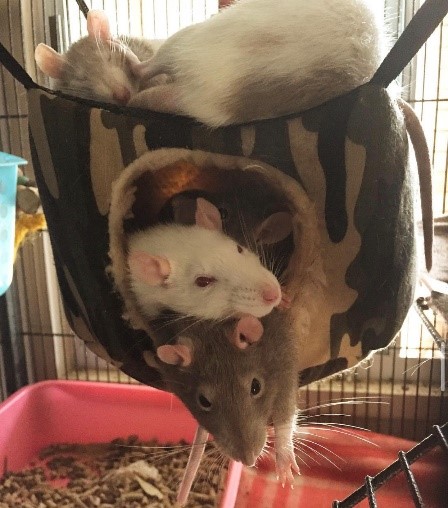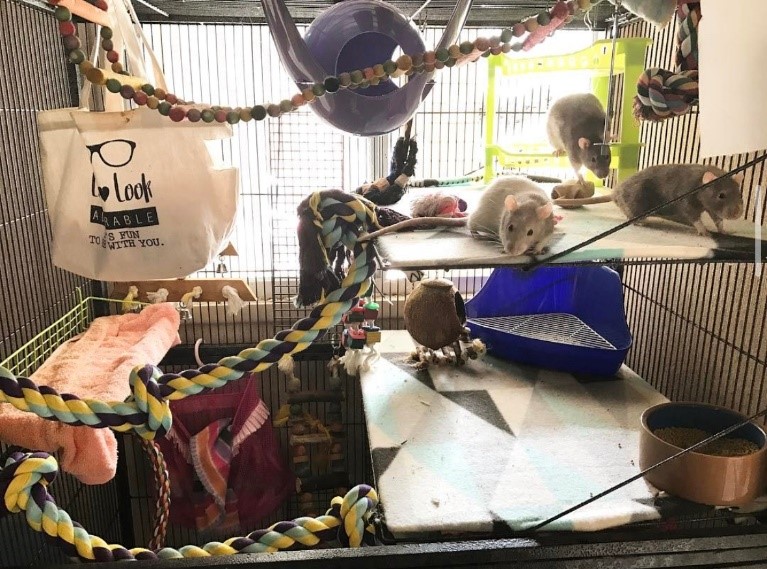Location
Where you place your rats’ enclosure is just as important as the type of enclosure and its accessories.
So, where can you place the enclosure? A good option is on a table in a room that is not too busy or noisy but that you use often so that your rats feel like part of the family; for example, a corner of a family room, living room, or bedroom (although be aware that they are most active at night, so an enclosure in a bedroom might disturb your sleep!). Your rats will enjoy seeing you or others in the household come and go, but the enclosure should not be somewhere that is very busy (such as a hallway with constant through traffic) as they also need some peace and quiet. The enclosure should have about 8 to 12 hours of quiet, dark time each day.
Places to avoid:
- The floor: Placing the enclosure on a table or elevated surface is better than directly on the floor. Floors can get cold (especially in winter) and are often draughty.
- Hot and cold spots: Avoid placing the enclosure anywhere that might be hot or cold, such as in direct sunlight or near heaters or air conditioners.
- Near excessive noise: Areas near noisy appliances, in the garage, beside the television, or any other noisy spots should be avoided.
- High humidity areas: Anywhere that is likely to be humid (such as bathrooms or the laundry) should be avoided.
- Areas exposed to potentially toxic fumes: The kitchen or the garage are not safe for your rats due to the likely presence of potentially toxic fumes (such as those from burning food or cookware and chemicals). Avoid other areas where you keep or use chemicals or which might be more likely to risk exposure to smoke or fumes (e.g., in a room with a fireplace).
The enclosure
Now that you have decided where to place the enclosure, it’s time to think about the enclosure itself. Before buying anything, give some thought to:
- Size
- Security
- Safety
- Ventilation
- Ease of cleaning
Size
Rats need plenty of space so they can engage in the behaviours which are important to them like foraging, nesting, hiding, resting, enjoying time with and apart from their rat companions, playing, exercising, and grooming.
The more space and environmental complexity in their living space the better for these active and intelligent animals. When designing the enclosure for your rats, it is important to think about the behaviours they find rewarding and the resources they need (e.g., food, water, hiding and nesting places, toys etc – see this article for more information) and make sure that the enclosure is big enough to accommodate all of that comfortably. It should be as big as you can afford, maintain, and have room for. Unfortunately, there are currently no evidence-based recommendations for the optimal size of companion rat housing. Published guidelines for rat housing size are generally limited to those for rats kept in laboratory settings rather than as companions.
Multiple levels in the enclosure can be used to provide more space and interest for your rats. Adding two or more levels, connected by ladders or ramps, will increase the space available, give your rats the opportunity to explore and climb, and give them more choice and control over their environment.
Security
Rats are agile, nimble, and very fast. They climb and they gnaw. A proper, fully enclosed habitat prevents escapes. It should also protect your rats from other animals (including other pets) and even people (especially small children). Rats are adept at manipulating items, so the enclosure needs doors that close securely. Large doors, while making cleaning, feeding, and reaching your pet rats easier, also provide an escape route for a determined rat.
The ability to escape and hide from predators (real or imagined) can give your rats an added sense of security. Make sure you provide plenty of hides in easy reach – your rats will be much more comfortable knowing they can seek shelter in a split second.

Safety
A solid floor is preferred, as wire mesh floors might cause injury by trapping a foot or causing foot irritation that leads to the infection pododermatitis (bumblefoot). Enclosures are available with plastic bottoms but be sure to get one that has sides high enough to keep bedding, faeces, or other debris that falls through the bars inside the enclosure. Sides about 5-10cm high usually work for this.
Make sure that any additions to the enclosure (e.g., water bottles, toys, sleeping hammocks, etc), are securely fastened in a ‘rodent-proof’ manner.
Choose an enclosure with bar spacing that prevents escapes or your pets getting trapped. Opt for bar spacing of no larger than 2.5cm for adult rats (smaller for juveniles).
The enclosure should be monitored for sharp edges from chewed plastic and any materials that could cause constriction injuries or can catch claws or teeth (e.g., loose weave long-fibre fabrics/fluffy bedding/metal chains) should be avoided. Likewise, materials that could pose problems if ingested should be avoided, including rubber objects.
Ventilation
Rats urinate a lot! Unless their enclosure is well-ventilated, this can lead to a build-up of ammonia fumes that can cause respiratory illness and stress in rats. Wire sided/topped enclosures offer the best ventilation by far. Any solid-sided enclosure, even with a mesh lid, has much less ventilation and will cause problems.
Ease of cleaning
Frequent cleaning is a must to safeguard the health of your rats, so think about how easy an enclosure will be to clean. Bedding must be spot-checked daily, with soiled areas removed and replaced. All solid surfaces (flooring, shelves, exercise wheels, and toys) in the enclosure will need daily cleaning. You will need to check for stashes of any fresh foods and remove them each day. If you want a job done properly, it must be easy to do – your pet’s enclosure must reflect this.
I’ve got my rats’ enclosure – what do I need to add to it to make it a home?
Setting up the enclosure for your rats can be a lot of fun, as you can let your imagination run wild! What things do you need to think about putting in there?
- Substrate
- Food dishes
- Water bowls or bottles
- Hides
- Play areas

Substrate
Solid bottom enclosures with deep bedding and ample nesting material are ideal. The bedding must be clean, non-toxic, absorbent, and relatively dust free. A great substrate is a base of cat litter made from recycled newspaper. Another option is a commercial rodent substrate made from shredded paper. Avoid cotton wool (it can wrap around the feet), aromatic/treated wood shavings (can be irritant or even toxic), and hay/straw or processed corn cobs (can be a source of mould and dust) – these are NOT suitable bedding materials. Change the bedding daily. At least one area of bedding (3-4 cm deep) should be provided to allow for normal burrowing behaviour.
Food dishes
Multiple feeding areas are recommended to avoid competition for food that may turn to aggression. Foraging toys or scattering food through the enclosure may be preferable to bowls. For example, hiding food within a cardboard egg carton can be challenging and entertaining for your rats, and easily disposed of when soiled or no longer serviceable. Food dishes should be heavy to resist being pushed around. Ceramic dishes work well for this. If you offer dry food and fresh veggies or fruit, place them in two separate dishes. Make sure all dishes are emptied and washed daily.
Water bowls and bottles
Water bottles help keep water clean and the enclosure drier than water bowls. If you do choose bowls, again, opt for heavy ceramic dishes. Water bottles should be easy to clean. Wash them daily in warm water with mild soap, rinse thoroughly and fill with fresh water. Choose bottles made from glass or other chew-resistant material. Check the bottles daily to ensure that the bottle is functioning normally (e.g., not blocked or leaking). Provide several different water options to prevent competition.
Hides
A hide area is a must to allow your rats to escape and feel secure if they feel threatened, or just want some privacy. Don’t provide just one – your rats won’t want to be too far away from a hide at any time, and you want to minimise competition. They can be anything your pet can hide in, from a cardboard tube to a small cardboard box to a PVC pipe, to a purpose-made plastic structure. Cardboard boxes and tubes will need to be replaced frequently, but rats enjoy hiding in – and destroying – these. A hide made from fabric, such as a hammock or cube, might work, although you need to watch it carefully – if your rats chew on the fabric, take it away before they eat it and develop a gastrointestinal blockage.
Play areas
Setting up a play area for your rats can provide them with a lot of fun. Some owners like to do this outside the enclosure, but obvious risks are associated with this. Some toys and environmental complexity inside the enclosure offer enrichment for your rats. An exercise wheel of an appropriate size is a ‘must have’. The ideal wheel has a solid running surface to prevent a foot being caught and is large enough to allow your pet to run without arching their back in a U-shape.
Other toys include tunnels, safe chew blocks, hard plastic toys, etc. Any non-toxic object that resists chewing or is safe for rats to chew might make a good toy. Avoid anything that could injure them or have tiny pieces that could fall off and be ingested.
See this article for more information on using environmental enrichment to provide opportunities for your rats to experience good welfare.
References
Evans E (2006) Small rodent behaviour: rats, rats, gerbils, and hamsters. In: Bays TB, Lightfoot T, Mayer J (eds) Exotic Pet Behavior. W.B. Saunders, pp 239–261
Frohlich J (2020) Rats and rats. In: Quesenberry KE, Orcutt CJ, Mans C, Carpenter JW (eds) Ferrets, rabbits and rodents, 4th ed. W.B. Saunders, pp 345–367
Girling S (2013) Small mammal husbandry, housing and rearing. In: Veterinary Nursing of Exotic Pets. John Wiley & Sons, Incorporated, Newark, pp 26–35
Lennox A, Bauck L (2012) Small Rodents – Basic anatomy, physiology, husbandry, and clinical techniques. In: Quesenberry K, Carpenter J (eds) Ferrets, Rabbits and Rodents Clinical Medicine and Surgery, Third. Elsevier Health Sciences, pp 339–353
Neville V, Hunter K, Benato L, Mendl M, Paul ES (2022) Developing guidelines for pet rat housing through expert consultation. Veterinary Record. https://doi.org/10.1002/vetr.1839

